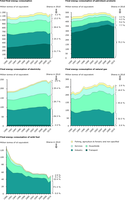
Consists of 5 figures that show the total final energy consumption, final energy consumption of petroleum products, final energy consumption of electricity, final energy consumption of natural gas and final energy consumption of solid fuel, all by sector in the EU-27.

Total energy intensity (index 1995=100), relative energy intensity (as PPS) and per capita consumption

The figure shows the emissions of hydrofluorocarbons (HFCs), perfluorocarbons (PFCs) and sulphur hexafluoride (SF6) on Production, Imports, Exports and Consumption from 2007 to 2011. Emissions are provided in Mt CO2 equivalent using the Global Warming Potential values of the 3rd IPCC Assessment report (TAR).

The pie-chart summarizes the type of treatment applied in the wastewater treatment plants of 586 big cities/big dischargers (250,2 mil. p.e.) reported in 2011 by the Member States and Norway. In total 640 big cities and big dischargers was reported, however complete data on waste water pathways was available only for 586.

The graph shows development of specific CO2 emissions for the road transport mode, by category (passenger cars, vans, two wheelers, buses & coaches, light-duty vehicles, heavy-duty vehicles) in 1995, 2005 and 2011.
Data coverage: EEA-32 excluding Iceland and Liechtenstein

The graph shows development of specific CO2 emissions, defined as emissions of CO2 per transport unit (tonne-km), by freight transport mode (road, rail, maritime, inland shipping) over the period 1995 to 2011.
Data coverage: EEA-32 excluding Iceland and Liechtenstein

The graph shows development of specific CO2 emissions, defined as emissions of CO2 per transport unit (passenger-km), by passenger transport mode (road, rail, maritime, air) over the period 1995 to 2011.
Data coverage: EEA-32 excluding Iceland and Liechtenstein

Bar chart showing final energy consumption broken down by different fuel types. Orange line shows total energy consumption for oil derived fuels, dotted red line shows transport target on oil consumption that applies to EU27 (Transport White Paper, 2011).

Annual changes in temperature and precipitation in northern (top panels) and southern Europe (bottom panels) for the
periods 2030–2049 (left panels) and 2080–2099 (right panels) relative to 1961–1990. GCM simulations for the SRES A1B
scenario, which assumes rather high population and economic growth and a balanced use of energy sources, are shown with
green points. Comparable simulations for the ENSEMBLES E1 mitigation scenario are shown with orange points.

The reported change in polycyclic aromatic hydrocarbons (PAH) emissions for each country, 1990-2010.

The reported change in hexachlorobenzene (HCB) emissions for each country, 1990-2010.

The reported change in mercury (Hg) emissions for each country, 1990-2010.

The map shows the perception of the cities’ population on their trust in other people living in the city; it is therefore a proxy for social capital.

Insurance penetration as proportion of GDP per country

(upper) Areas affected by three recurrent negative precipitation anomalies (as indicated in the graph: 2000, 2003 and 2006 during the period 1999–2010 based on the standardised precipitation index, a statistical correlation to recurrent anomalies through principal component analysis (PCA) of time series climatic data). The prevalence of recurrent negative precipitation anomalies in the Mediterranean area is very apparent. Such anomalies can also affect areas with traditionally humid climates.
(lower) The effect of these events on ecosystem productivity based on a change index: the steadiness index. This index addresses both the long-term trend and the net change of primary production calculated from satellite time series over the period in which the recurrent negative precipitation anomalies occurred (1999–2010). The areas in red denote regions with a stronger likelihood of decreased productivity relative to the ecosystem capacity.

The graph shows the proportion of urban population of the overall population in Europe and the absolute numbers of urban population over time

Projections of economic costs from climate change and socio-economic developments for four major categories for two different socio economic scenarios and three different future periods.
Left: damage costs for the A1B scenario for energy for cooling, heat-related mortality (weighted average of Value of a Statistical Life (VSL) and Value of a Life Year Lost (VOLY)), river floods and coastal zones. Time horizon: 2010–2040, 2040–2070 and 2070–2100.
Right: A1B and E1 scenarios, 2070–2100.

Projected distribution of economic costs from climate change and socio-economic developments by impact type and European region. EU-27 only; A1B scenario, 2070–2100, combined effects of climate change and socio-economic change

(Environmental) Combined potential impacts of changes in summer and winter precipitation, heavy rainfall days, annual mean temperature, summer days, frost days, snow cover days and annual mean evaporation on soil erosion, soil organic carbon content, protected natural areas and forest fire sensitivity.
(Economic) Combined potential impacts of changes in annual mean evaporation, summer days, snow cover days, frost days, changes in inundation heights of a 100 year river flood event and a sea level rise adjusted 100 year coastal storm surge event on agriculture, forestry, summer and winter tourism, energy supply and demand.

Left: present climate; middle: projection for 2050 based on Economy First scenario, median of general circulation models — regional climate models (GCM-RCM) combinations;
right: projection for 2050 based on Sustainability Eventually scenario, median of GCM-RCM combinations.
Yellow: low water stress (withdrawals-to-availability ratio: 0–0.2);
orange: mild water stress (withdrawals-to-availability ratio: 0.2–0.4);
red: severe water stress (withdrawals-to-availability ratio: > 0.4).